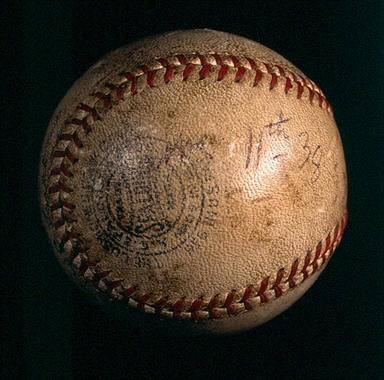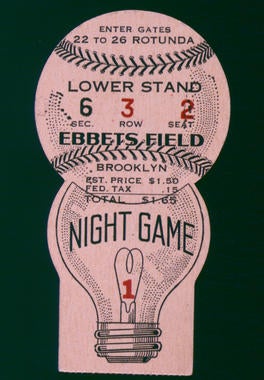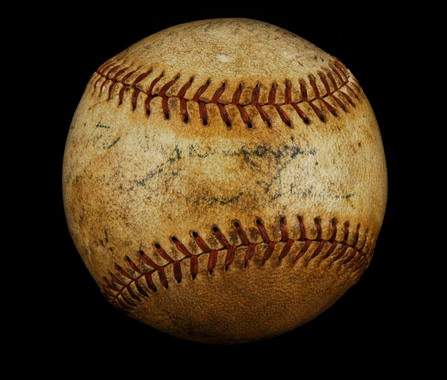“Gee, I had no idea of pitching a no-hitter. My arm felt better as I went along. I just kept pouring ‘em in.”
Make His a Double
More than 9,000 men have taken the mound in a big league game, but what pitcher Johnny Vander Meer accomplished more than three quarters of a century ago by tossing back-to-back no-hitters is considered by many one of the game’s most unbreakable records.
At the start of the 1938 season, the 23-year-old Vander Meer of the Cincinnati Reds, who consistently had trouble controlling his fastball throughout his career, was still an unproven hurler. Though he had experienced success in the minors, such as when won 19 games and struck out 295 batters for the Piedmont League’s Durham Bulls in 1936, he had yet to establish himself at the big league level. He had made his big league debut the previous season with mediocre results and was soon sent back to the minors.
While the Reds were cautiously optimistic regarding Vander Meer’s chances of success in 1938 – what would be the young southpaw’s first full season in the majors - no one foresaw the mid-June pair of events that was about to shock and amaze the baseball world.
“Double No-Hit,” as Vander Meer would soon be nicknamed, began his remarkable stretch on June 11 at Crosley Field in Cincinnati, walking three while striking out four and allowing no hits and no runner past first base in a 3-0 win against the Boston Bees. Four days later, on June 15, Vander Meer walked eight and struck out seven while holding the Dodgers hitless in a 6-0 triumph in the first night game at Brooklyn’s Ebbets Field.
The National Baseball Hall of Fame and Museum’s permanent collection includes a baseball from Vander Meer’s June 11 no-hitter and a ticket stub from the June 15 no-hitter.
Having worked on a new delivery aimed to improve his control during spring training, Vander Meer was off to a good start in 1938. He entered the Saturday, June 11 game with a 5-2 record and a league-leading 52 strikeouts. In control throughout, he retired the first nine batters before issuing a walk to start the fourth inning. The fourth also saw the no-hitter almost broken up, as Boston’s Vince DiMaggio lined a shot off Vander Meer’s glove, the ball deflected to third baseman Lew Riggs, whose throw to first base just beat the runner.
“Gee, I had no idea of pitching a no-hitter. My arm felt better as I went along. I just kept pouring ‘em in,” said Vander Meer afterward. “My arm seemed to become stronger as the game went along.
“I had excellent control of my curve in the final four rounds, which made my fastball doubly effective. I put everything I had on every pitch in the ninth against pinch-hitters (Bob) Kahle, (Harl) Maggert and (Ray) Mueller.”
When it was over, the 10,311 in attendance had witnessed the first Reds no-hitter since Hod Eller’s in 1919.
Four days later, Vander Meer’s attempt at his historic second consecutive no-hitter coincided with the first-ever night game to be played in the metropolitan New York City area. According to reports, the lights came on precisely at 8:35 p.m. and the 38,748 in attendance (the fire department had to turn away an estimated 10,000 hoping to pay $1.10 for seats or 55 cents for access to the bleachers), the second-largest crowd to ever attend a game in Brooklyn, let out a loud cheer.
After a pregame show that included a band and two drum and bugle corps provided by the American Legion, an exhibition by 1936 Olympic hero Jesse Owens and an appearance by the great Babe Ruth, the game’s first pitch was made at 9:45 p.m. When it was over, with 1,200,000 watts of electric lighting units flooding Ebbets Field, Vander Meer became the first pitcher in baseball history to not only hurl two no-hitters in the same season but also to do it in successive starts.
Before the game, Ruth congratulated Vander Meer on his no-hitter against Boston. “I was pleased to have merited his, ‘Nice going, kid,’ at that time,” Vander Meer would later say.
Though he was wild against the Dodgers, as demonstrated by his eight walks, Vander Meer managed to work his way out of trouble on each occasion. This was demonstrated in the ninth when, after getting the first batter, Vander Meer walked the next three – Babe Phelps, Cookie Lavagetto and Dolph Camilli. After a visit to the mound by Reds manager Bill McKechnie, Vander Meer first got a force play at home on a groundball, then, with a 2-2 count, Leo Durocher lofted a fly ball into short center and into the waiting glove of Harry Craft to end the game.
“I honestly could have run over and thanked Garms when he made that hit. Now maybe I can get a good night’s sleep for a change.”
“I’m glad that’s over,” a grinning Vander Meer said after the game. “I only wish the first man up could have hit and ended the strain.
“I honestly could have run over and thanked Garms when he made that hit. Now maybe I can get a good night’s sleep for a change.”
Vander Meer, known as “The Dutch Master” because his parents were born in Holland, finished 1938 season with a 15-10 mark, the two no-hitters coming in the midst of an eight-game winning streak during which he had a 1.38 ERA. Named to start that year’s All-Star Game played at Crosley Field, he went three scoreless innings for the win in the NL’s 4-1 triumph. His big league career would come to an end in 1951 having compiled a 119-121 record.
Bill Francis is the senior research and writing specialist at the National Baseball Hall of Fame and Museum




